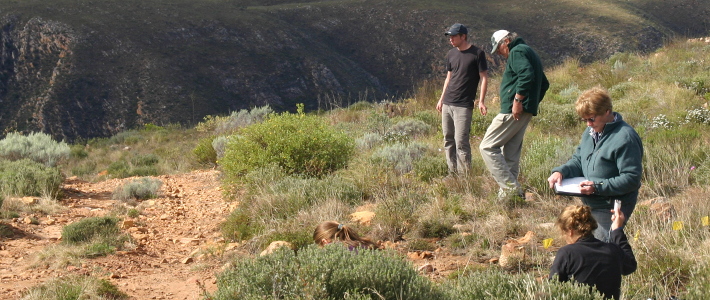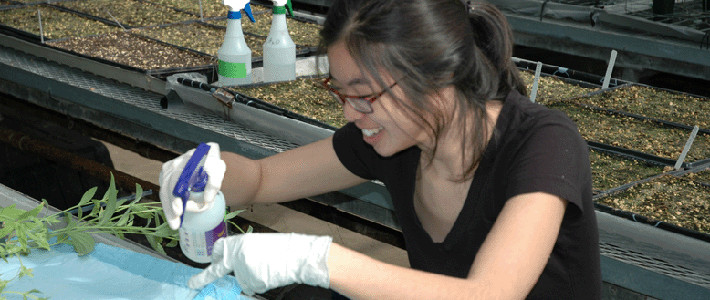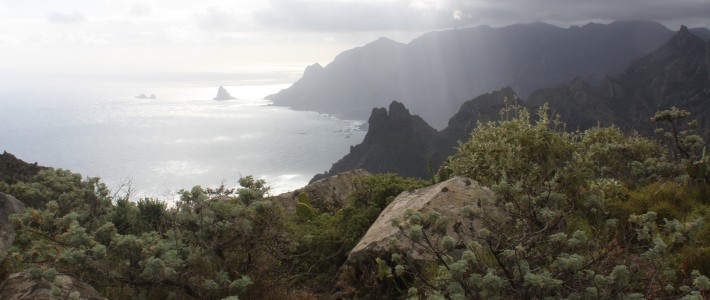EEB Greenhouse Hazard Communication Policy
Introduction
As part of its continuing effort to reduce exposure and risk to University of Connecticut employees, the Ecology & Evolutionary Biology Greenhouse has implemented this Hazard Communication Program to provide information about hazardous chemicals used in the workplace and appropriate preventive and protective measures. This written program is designed to comply with the requirements of the Occupational Safety and Health Administration (OSHA) Hazard Communication Standard (29 CFR 1910.1200).
Mr. Clinton Morse is responsible for coordinating and administering the Hazard Communication (HAZCOM) program for Ecology & Evolutionary Biology Greenhouse Facilities.
He serves as the first point of contact for employees on Hazard Communication issues for these facilities. Additional information and support is available through Environmental Health and Safety (EH&S).
Scope
This written program applies to all covered employees of the University of Connecticut Storrs campus and branch campuses.
A covered employee is defined as a worker who may be exposed (actually or potentially) to hazardous chemicals under normal operating conditions or in foreseeable emergencies, e.g., an equipment malfunction resulting in an uncontrolled release of a hazardous chemical.
Generally, this written program does NOT cover office workers or other employee groups whose jobs would not be likely to involve chemical exposures, or who may encounter hazardous chemicals only in non-routine, isolated instances. Employees within these job classifications would, however, be covered if their normal work routine required them to walk through areas where hazardous chemicals are used/stored.
Laboratory personnel are covered by a different OSHA standard, "Occupational Exposure to Hazardous Chemicals in Laboratories." For more information on the laboratory standard, consult the University’s Chemical Hygiene Plan, available from EH&S.
Hazardous Materials Inventory
Each department is required to maintain an inventory of the hazardous materials used or stored for non-laboratory use by departmental employees. The Hazardous Material Inventory for Ecology & Evolutionary Biology Greenhouse is attached as Appendix B.
This inventory lists each material as identified on the Material Safety Data Sheet (MSDS) and container label. Materials no longer present are deleted from the list and new materials are added as they are introduced into the workplace by Mr. Clinton Morse. This inventory must be attached to this written program and must be available to employees at each work location during normal work hours.
Material Safety Data Sheets (MSDS)
The Ecology & Evolutionary Biology Greenhouse has a current MSDS on record for each hazardous chemical in use. Mr. Clinton Morse is responsible for maintaining and updating the MSDS file(s). If an MSDS is not on file, Mr. Clinton Morse will request the MSDS from the manufacturer, importer or distributor of the product.
The University of Connecticut will rely on the initial hazard evaluation performed by the manufacturer, importer or distributor of the product.
MSDSs & product labels are located online at http://florawww.eeb.uconn.edu/chemical_list.html where they are readily accessible to employees during work hours. Where employees must travel between workplaces during a work shift, the MSDSs are kept in the primary work area. No employee is required to work with a hazardous chemical for which an MSDS is not available. EH&S does not maintain a central file of MSDSs for the University of Connecticut. However, MSDSs for many products are available through the Internet (for links to MSDS information, visit the EH&S website at http://w ww.ehs.uconn.edu/link.html#occupational). Furthermore, Central Stores maintains MSDSs for all materials that are in their inventory and that are supplied to the University community. For information on reading and understanding MSDSs, see Appendix C.
Product Labels and Other Forms of Warning
The purpose of labeling is to provide workers with information about the potential hazards of the chemicals they use and to provide information needed to allow an employee to find the corresponding MSDS. Original containers must be labeled, tagged or otherwise marked with the product name, manufacturer’s name and address, and appropriate hazard warnings. Any questions about the proper interpretations of these warnings should be referred to Mr. Clinton Morse who will, in turn, refer them to EH&S, as appropriate.
Secondary Containers into which chemicals have been transferred from an original labeled container must also be labeled. This is required if the product will be used for more than one work shift, or by more than one employee. Secondary containers must be labeled with the product name, and the appropriate hazard warnings. This can be done with either a pre-printed label or container supplied by the manufacturer or by physically writing this information directly on a container or blank label.
Labels must be included on stationary processes containing hazardous chemicals and piping systems (except those used for conventional heating and cooling) that pass through areas that are normally occupied, or where personnel may be exposed in the event of a leak or rupture. These locations include: [list affected stationary processes and piping systems]
No one shall intentionally deface or obscure container labels or hazard warnings on incoming containers of hazardous materials. Supervisors of employees using hazardous materials are responsible for ensuring that labels are legible on all containers in their work area.
Labeling systems, such as the Hazardous Materials Identification System (HMIS) or the National Fire Protection Agency (NFPA) Diamonds, may be used to complement, but not replace, labeling requirements. Additional training is required for these labeling systems. Additional labeling systems that are in use in this department include: [list additional labeling systems]
Training
All employees potentially exposed to hazardous materials in the workplace must be provided with training prescribed in the Hazard Communication Standard. It is the responsibility of Mr. Clinton Morse to provide job-specific chemical safety training and to contact EH&S to make arrangements for general training of new employees prior to any job assignment involving work with hazardous substances.
The training includes, as a minimum:
- the provisions of the OSHA Hazard Communication Standard, including:
- what is an MSDS, what information do MSDSs contain, and how they are obtained,
- labeling requirements and how labels relate to MSDSs,
- requirements and elements of a written Hazard Communication Program,
- requirements for training.
- an overview of general toxicology, including methods to recognize hazards, hazard evaluation, and common methods to prevent and control employee exposure.
More specific information on certain hazardous materials or categories of materials used in the workplace is provided to employees by the department. Supervisors or designees are responsible for informing employees of:
- the location and availability of the written Departmental Hazard Communication Program, the chemical inventory, and the MSDS file;
- the nature and potential health and safety risks of hazardous substances to which employees are exposed in the course of their employment;
- proper handling procedures, including use of personal protective equipment, for hazardous materials to which employees are exposed in the course of their employment;
- appropriate emergency treatment for exposures and procedures for cleanup of leaks and spills; and
- the location of hazardous substance containers present in their workplace.
Additional training must be provided to employees when new hazards are introduced into the work area, and before any changes in operation which may affect the hazard to which they may be exposed.
Outside Contractors
The Ecology & Evolutionary Biology Greenhouse will provide a copy of this written Hazard Communication Program, the chemical inventory, and the opportunity to review MSDSs on file to contractors planning to work in an area where hazardous chemicals are used or stored. Per the OSHA Hazard Communication Standard, the contractor is expected to inform and provide the Ecology & Evolutionary Biology Greenhouse with a chemical inventory and MSDSs of the materials to be introduced into the work area in the course of their work at the University of Connecticut. The contractor must also provide information on the location of chemical use and storage to the Ecology & Evolutionary Biology Greenhouse. The contractor is responsible for the removal of all unused portions of the chemicals and their waste products from the University.
Non-Routine Tasks
Special hazards which employees may encounter when performing non-routine duties in the course of their work will be discussed with the employee before the job begins. It is the responsibility of the supervisor to ensure that employees receive necessary specialized training. Information will be provided on safe handling, personal protective equipment, appropriate exposure monitoring, and other possible control measures. Assistance in evaluating the hazards of non-routine tasks and determining the appropriate precautions and protective measures is available from EH&S. Written standard operating procedures will be attached to this department’s written Hazard Communication Program.
Responsibilities
Supervisor (or designee)
- Coordinates and administers the Hazard Communication Program for the greenhouse facilities;
- Acts as first point of contact for employees with questions related to Hazard Communication;
- Maintains hazardous materials inventory that can easily be cross-referenced to the container labels and MSDSs, and reviews annually;
- When new hazard inventories are produced, saves old inventories in an archival file in accordance with OSHA’s record retention requirements;
- Ensures that the inventory and the written program are readily accessible to all appropriate personnel during their normal working hours when they are in their work areas;
- Acquires and maintains MSDSs;
- Ensures that the MSDSs are readily accessible to all appropriate personnel during their normal working hours;
- Provides contractors and supervisors of other departments with necessary information (chemical hazards, labeling information, location of MSDS, etc.);
- Obtains information from contractors and supervisors of other departments regarding chemicals they will use in work areas;
- Reviews written Hazard Communication Program and audits effectiveness at least annually (See Appendix E);
- Ensures all containers, stationary processes, and affected piping systems are properly labeled;
- Ensures employees attend required general training provided by EH&S, or provides the general training and site-specific training under EH&S’ Train-the-Trainer Program;
- Provides chemical and area-specific training to employees, with assistance from EH&S, as needed;
- Provides re-training when a new chemical hazard is introduced;
- Ensures employees receive necessary specialized training for non-routine tasks;
- Ensures that employees are provided with and use all designated engineering controls and personal protective equipment, heed all chemical hazard warnings, and follow safe usage instructions.
- Develops written emergency procedures to be followed in the event of a hazardous chemical release or exposure (see attached example, Appendix D);
- Reports all significant spills or releases of hazardous chemicals to the University Fire Department by dialing 911;
EH&S
- Assists departments in developing and implementing a Hazard Communication Program;
- Assists departments in obtaining MSDSs, when necessary;
- Develops and provides general and Train-the-Trainer training;
- Assists supervisors with specific training, when necessary;
- Maintains training records of general training classes, and Train-the-Trainer Program classes conducted for supervisors or designees;
- Provides advice on health and safety issues related to chemical safety and handling;
- Conducts employee chemical exposure monitoring, where appropriate;
- Periodically audits Hazard Communication Programs.
Employee
- Attends general and specific training;
- Does not deface container labels;
- Labels new containers not meeting the definition of process containers appropriately;
- Reviews each product’s container label and MSDS before using it;
- Notifies supervisor when there is a problem with the hazardous chemical inventory, label, MSDS, or if there is a health and safety concern;
- Uses personal protective equipment appropriately;
- Works with hazardous chemicals in a safe manner, following guidelines outlined in training.
Additional Information
Further information on the OSHA Hazard Communication Standard, the University’s Hazard Communication Policy, this written program, and the hazardous chemical listing, labeling and MSDS requirements is available by contacting the Department of Environmental Health and Safety, 3102 Horsebarn Hill Rd., U-97, Storrs, CT 06269-4097 (486-3613)
Appendices
- APPENDIX A – UConn Hazard Communication Standard
- APPENDIX B – Hazardous Chemical Inventory
- APPENDIX C – Reading and Understanding MSDS Information
- APPENDIX D – Emergency Procedures
- APPENDIX E –– Hazard Communication Program Review Reviews must be conducted at least annually by supervisors or designated personnel
- Hazard list reviewed and updated
- MSDSs reviewed and updated
- Containers inspected for proper labeling
- Written program reviewed and modified if necessary
- Employees informed of any new hazards introduced
- Emergency procedures reviewed and modified if necessary
- New employees scheduled for training
- Employees who need refresher training identified and scheduled for training
Reviewer Name: Clinton Morse
Date Review Completed: September 21st, 2006
This written program has been adapted from the Princeton University Environmental Health and Safety world wide web site (http://www.princeton.edu/~ehs/). Copyright 1997, all rights reserved, Princeton University Environmental Health and Safety.
Research Links
- 30-Day Pesticide Spray List
- MSDS/Labels
- Current Chemical Inventory
- Federal Worker Protection Standard
- Hazard Communication Policy









